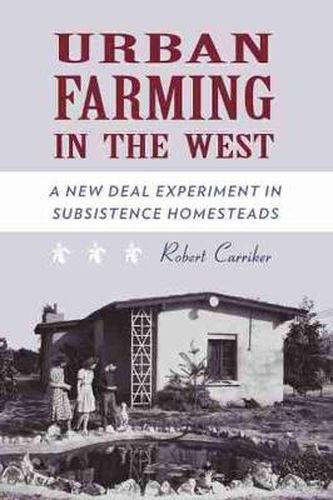Readings Newsletter
Become a Readings Member to make your shopping experience even easier.
Sign in or sign up for free!
You’re not far away from qualifying for FREE standard shipping within Australia
You’ve qualified for FREE standard shipping within Australia
The cart is loading…






From 1933 to 1935, the federal government’s Division of Subsistence Homesteads created thirty-four New Deal communities that sought to provide a healthier and more economically secure life for disadvantaged Americans. These settlements were designed to combine the benefits of rural and urban living by offering part-time farming, uplifting social functions, and inexpensive homes. Four were located in the West: in Phoenix, Arizona; El Monte and San Fernando, California; and Longview, Washington. Robert Carriker examines for the first time the intricate histories of these subsistence homestead projects, which have long been buried in bureaucratic records and clouded by misunderstanding, showing that in many ways they were among the agency’s most successful efforts. He provides case studies of the projects, rescuing their obscure histories using archival documents and rare photographs. He also reveals the machinations of civic groups and private citizens across the West who jockeyed for access to the funds being allotted for New Deal community building. By describing what took place on these western homesteads, Carriker shows that the DSH’s agenda was not as far-fetched as some have reported. The tendency to condemn the Division and its projects, he argues, has failed to appreciate the good that came from some of the individual homestead communities–particularly those in the Far West. Although overshadowed by the larger undertakings of the New Deal, some of these western communities remain thriving neighborhoods–living legacies to FDR’s efforts that show how the country once chose to deal with economic hardship. Too often the DSH is noted for its failures; Carriker’s study shows that its western homesteads were instead qualified accomplishments.
$9.00 standard shipping within Australia
FREE standard shipping within Australia for orders over $100.00
Express & International shipping calculated at checkout
From 1933 to 1935, the federal government’s Division of Subsistence Homesteads created thirty-four New Deal communities that sought to provide a healthier and more economically secure life for disadvantaged Americans. These settlements were designed to combine the benefits of rural and urban living by offering part-time farming, uplifting social functions, and inexpensive homes. Four were located in the West: in Phoenix, Arizona; El Monte and San Fernando, California; and Longview, Washington. Robert Carriker examines for the first time the intricate histories of these subsistence homestead projects, which have long been buried in bureaucratic records and clouded by misunderstanding, showing that in many ways they were among the agency’s most successful efforts. He provides case studies of the projects, rescuing their obscure histories using archival documents and rare photographs. He also reveals the machinations of civic groups and private citizens across the West who jockeyed for access to the funds being allotted for New Deal community building. By describing what took place on these western homesteads, Carriker shows that the DSH’s agenda was not as far-fetched as some have reported. The tendency to condemn the Division and its projects, he argues, has failed to appreciate the good that came from some of the individual homestead communities–particularly those in the Far West. Although overshadowed by the larger undertakings of the New Deal, some of these western communities remain thriving neighborhoods–living legacies to FDR’s efforts that show how the country once chose to deal with economic hardship. Too often the DSH is noted for its failures; Carriker’s study shows that its western homesteads were instead qualified accomplishments.